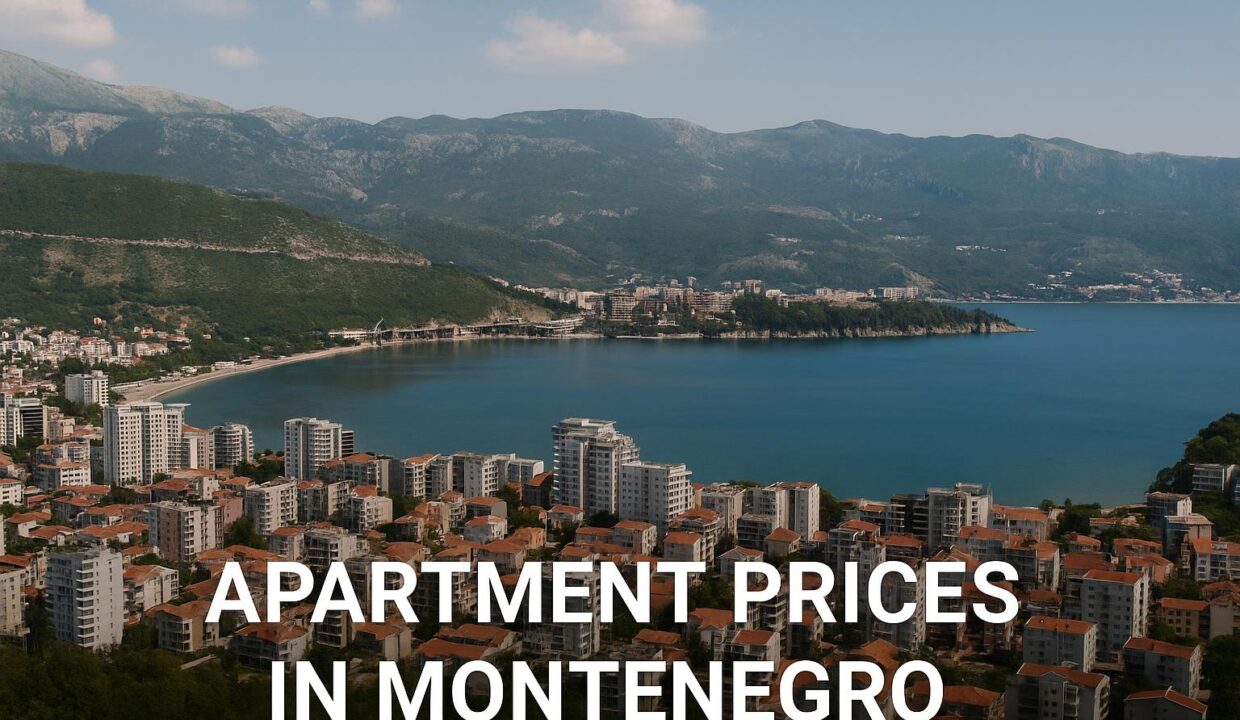
Average Apartment Prices in Montenegro 2025 – Local and Global Analysis
By: Editorial – Pisco Real Estate Blog
The real estate market in Montenegro is currently in one of its most dynamic phases in the past decade.
In Podgorica alone, new-build prices have more than doubled compared to 2020, while the coast remains the absolute leader when it comes to foreign buyers’ interest.
Yet, behind these numbers lies a much broader story: from inflation and construction costs to global geopolitical shifts, interest rate movements, and tourism trends.
New-build Prices by Region (Q2 2025)
| Region | Price €/m² |
|---|---|
| Montenegro (average) | 2,201 |
| Podgorica | 2,108 |
| Coastal region | 2,333 |
| Central region | 1,068 |
| Northern region | 1,547 |
Resale Market by City
| City | Average €/m² | Notes |
|---|---|---|
| Podgorica | ~2,290 (resale), 2,640 (new-build listings) | Most expensive: Central Point, City kvart/Master, Preko Morače |
| Budva | ~3,760 | Center and Bečići carry the premium |
| Tivat | ~5,040 | Porto Montenegro and marina resorts >10,000 €/m² |
| Kotor | ~3,705 (Old Town >5,300) | Dobrota and Škaljari mid-range |
| Bar | 1,700–2,100 | Šušanj and Dobra Voda wider range |
| Nikšić | ~1,000 | City center above average |
Average Prices by Apartment Type
| City | One-bedroom | Two-bedroom | Three-bedroom |
|---|---|---|---|
| Podgorica | 103–126k € | 137–172k € | 195–229k € |
| Budva | 169–207k € | 226–282k € | 300k+ € |
| Tivat | 227–277k € | 302–378k € | 400k+ € |
| Kotor | 167–204k € (Old Town 240k+) | 222–278k € (Old Town 318k+) | 350k+ € |
Local Market Dynamics
Podgorica shows steady growth driven by demographics and limited supply of quality new-builds. Areas like Central Point and City kvart command a premium, while Zabjelo and Stari Aerodrom remain more affordable.
The coast tells a different story: here prices are dictated by tourism and foreign demand. Tivat, with Porto Montenegro and luxury developments, stands out, while Budva and Kotor follow the trend thanks to the short-term rental market.
Inland towns – Nikšić and Danilovgrad are significantly cheaper but very sensitive to individual projects. Kolašin and Žabljak are exceptions, as ski tourism lifts apartment prices above the northern average.
Global Influences – From America to Japan
The outlook for Montenegro’s housing market cannot be assessed in isolation. Real estate is tied to global economic conditions and investor behavior.
United States – the U.S. labor market remains strong, with low unemployment, which sustains global liquidity. Any shift in Federal Reserve policy, especially regarding interest rates, echoes in Europe. High rates limit credit in the EU, indirectly affecting Montenegro, though much of the coastal market relies on cash buyers, softening the blow.
European Union – economic growth in the EU directly shapes demand in Montenegro. Germany and Italy, key partners, are slowing down, potentially reducing demand. At the same time, eurozone inflation pushes investors toward “safe havens” in real estate, benefiting Montenegro’s coast.
China and Japan – while China struggles with a real estate crisis, Japan’s central bank pursues an expansionary monetary policy. A weaker yen pushes Japanese investors to diversify abroad, with Europe (including Montenegro) as an option. Rising Asian tourism in Europe further boosts demand for short-term rentals in Budva and Kotor.
Geopolitics – the war in Ukraine and Middle East tensions create uncertainty, paradoxically raising Montenegro’s appeal as a small, safe market. Buyers from Russia, Ukraine, and the Middle East increasingly view the Montenegrin coast as a secure place for capital.
Tourism and remote work – the global shift toward remote work, combined with digital nomads, puts Montenegro on the map. Lower taxes, favorable climate, and proximity to EU markets make it competitive with Spain or Portugal, fueling demand for smaller apartments in Podgorica and coastal towns.
Forecast 2025–2026
- New-builds: expected growth of 3–6% annually, following inflation and construction costs.
- Resale market: older buildings without elevators or parking may stagnate or slightly decline, while renovated units in good locations hold value.
- Coastal region: the luxury segment remains strong, while the mid-market could see seasonal swings.
- Global factors: outcomes depend on EU and U.S. inflation, geopolitical events, and tourism flows. A deeper recession in Europe could slow growth, but no sharp price drops are expected.
Conclusion: Montenegro remains an attractive real estate market. Buyers seeking long-term value should focus on locations with stable demand – Podgorica for residential and business purposes, and the coast for tourism and rentals. Global economic cycles will continue to shape this market, but local demand and limited supply make sharp corrections unlikely in the near term.


